
Am Fam Physician. 2019;100(1):24-30
Patient information: See related handouts on lead poisoning in children.
Author disclosure: No relevant financial affiliations.
Asymptomatic lead poisoning has become more common in children. Blood lead levels of less than 5 μg per dL are associated with impairments in neurocognitive and behavioral development that are irreversible. Risk factors for lead poisoning include age younger than five years, low socioeconomic status, living in housing built before 1978, and use of imported food, medicines, and pottery. The U.S. Preventive Services Task Force released a recommendation in 2019 citing insufficient evidence to assess the balance of benefits and harms of universal screening for elevated blood lead levels in asymptomatic children and pregnant women. Local risk factors can be substantial, and the Centers for Disease Control and Prevention (CDC) recommends that states and cities formulate their own targeted screening guidelines. In the absence of local guidance, the CDC recommends screening all Medicaid-eligible children at 12 months and again at 24 months, or at least once between 36 and 72 months if not previously screened. The CDC also recommends universal screening in areas where more than 27% of the housing was built before 1950, or where at least 12% of children 12 to 36 months of age have blood lead levels greater than 10 μg per dL. Life-threatening lead levels are treated with chelation therapy, and lower levels should prompt case management and environmental investigations to identify and remove the source of exposure. Primary prevention strategies are essential to eliminate the harmful effects of lead on child development.
WHAT IS NEW ON THIS TOPIC
In 2012, the Advisory Committee on Childhood Lead Poisoning Prevention of the Centers for Disease Control and Prevention lowered the blood lead level to 5 μg per dL (0.24 μmol per L) to trigger further investigation and case management. More than 500,000 U.S. children were estimated to have high blood lead levels in 2017.
Blood lead levels of 5 μg per dL or less in apparently asymptomatic children have been repeatedly associated with impaired neurocognitive and behavioral development.
Children residing in communities with lead-containing water service lines, or poor anticorrosion control, are at an increased risk of lead poisoning from drinking water. Formula-fed infants have heightened risk of developing lead toxicity in these communities.
| Clinical recommendation | Evidence rating | Comments |
|---|---|---|
| Screening of all Medicaid-eligible children for blood lead exposure should occur at 12 and 24 months, or at least once between 36 and 72 months if not previously tested.5,14 | C | Expert consensus and elevated blood lead level prevalence data |
| Targeted screening questionnaires should be used to identify children who may be at elevated risk for lead poisoning.5,14 | C | Expert consensus |
| A capillary blood test is an acceptable screening method for lead poisoning, but any abnormal value should be confirmed with a venous sample.9 | C | Expert consensus |
| Chelation therapy should be used when a child's blood lead levels are greater than 45 μg per dL (2.17 μmol per L).4 | C | Expert consensus |
Lead poisoning is often asymptomatic. Even at higher blood lead levels (45 μg per dL [2.17 μmol per L] or greater) the symptoms are nonspecific and include headache, abdominal pain, anorexia, and constipation.3 At higher levels clumsiness, agitation or increased somnolence, vomiting, stupor, and convulsions can occur.3 Symptomatic lead poisoning is an emergency. However, even blood lead levels of less than 5 μg per dL (0.24 μmol per L) in apparently asymptomatic children have been clearly and repeatedly associated with impaired neurocognitive and behavioral development.2,4–9 These effects are irreversible, and a safe blood lead level has not been identified.7,9,10
The blood lead levels of U.S. children rose sharply in the early 1900s and peaked in the 1970s.11 Primary prevention strategies such as banning lead in paint, gasoline, and plumbing reversed the trend, but many children are still at risk of lead poisoning. As of 2017, more than 500,000 U.S. children are estimated to have blood lead levels of 5 μg per dL or greater.12
Abnormal Blood Lead Level
Lead has no biologic role in the body, and any detectable level is abnormal.3 In 2012, the Centers for Disease Control and Prevention (CDC) Advisory Committee on Childhood Lead Poisoning Prevention recommended that the blood lead level to trigger further investigation and case management be based on the 97.5 percentile of the previous two National Health and Nutrition Examination Surveys (NHANES) blood lead level distributions in one- to five-year-olds.4 Since 2012, that value has been 5 μg per dL. The CDC plans to update the reference value periodically using results from the two most recent NHANES and post the updated value at https://www.cdc.gov/nceh/lead.13
Sources of Lead
The most common sources of lead vary by geographic area. Lead-based paint, lead paint that contains house dust, and lead-contaminated soil are estimated to account for nearly 70% of elevated blood lead levels in U.S. children.14 The remaining 30% is attributed primarily to contaminated drinking water and imported goods such as candies, spices, pottery, and herbal remedies. Table 1 lists common lead sources.2,4
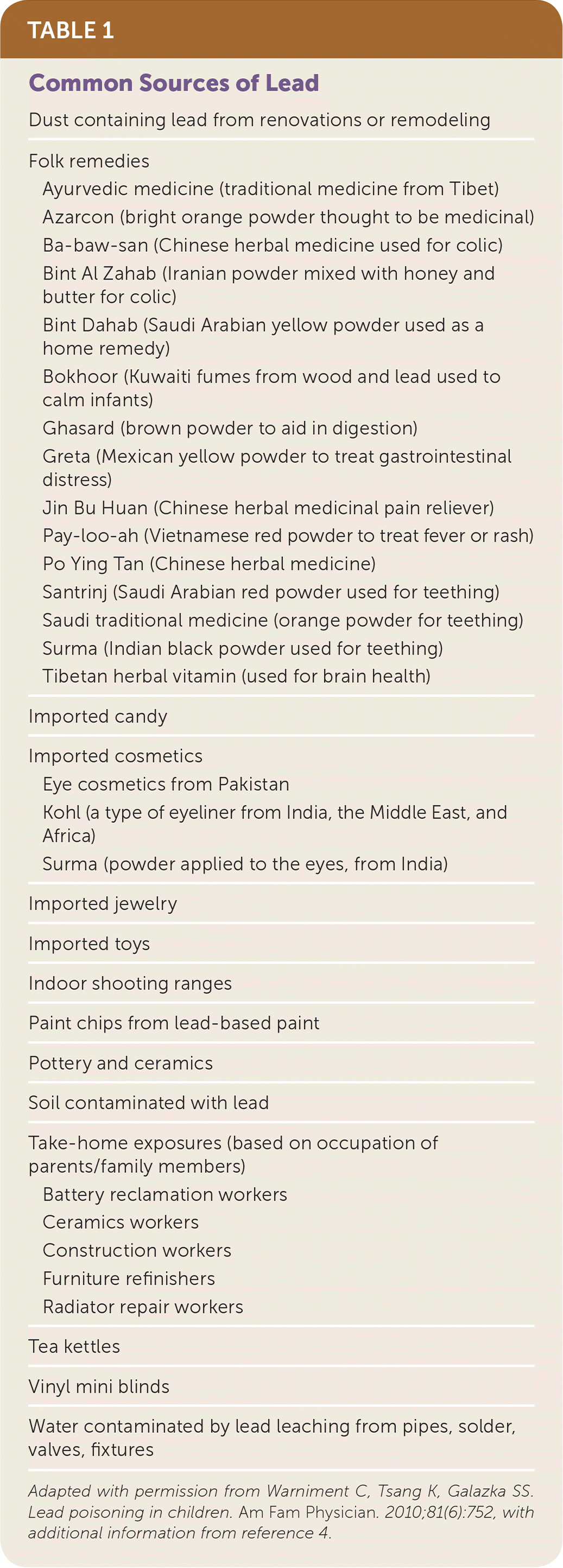
| Dust containing lead from renovations or remodeling |
Folk remedies
|
| Imported candy |
Imported cosmetics
|
| Imported jewelry |
| Imported toys |
| Indoor shooting ranges |
| Paint chips from lead-based paint |
| Pottery and ceramics |
| Soil contaminated with lead |
Take-home exposures (based on occupation of parents/family members)
|
| Tea kettles |
| Vinyl mini blinds |
| Water contaminated by lead leaching from pipes, solder, valves, fixtures |
Lead-based paint was banned in the United States in 1978.9 Homes built before 1978 have a high likelihood of having lead-based paint on the exterior and interior. The older the housing, the higher the hazard because the paint is more likely to contain higher concentrations of lead and to be peeling and deteriorating.9,10,14
Lead particles were released into the air for decades from cars using leaded gasoline; industrial emissions predominate today.14 Waste management plants, smelters, battery manufacturers, and regional airports with an abundance of piston-engine aircraft release the highest concentrations of lead, contaminating the soil of the surrounding communities.9,14 The soil can also be contaminated by peeling exterior paint on buildings constructed before 1978.
Water is an often overlooked source of lead contamination. Source water rarely contains lead unless a specific contamination has taken place. Instead, drinking water is contaminated during transportation from the treatment facilities to taps.11 Lead was common in plumbing materials and solder until its use in this manner was restricted in 1986.15 Although homes and businesses established after 1986 should not have lead-containing plumbing, common municipal lines and older homes and buildings likely still do because the replacement of lead-containing lines and pipes is expensive and voluntary. The solubility and particulate release of lead are affected by water softness, temperature, and acidity at the source or after treatment.15
Risk Factors
Children younger than five years are most at risk of lead poisoning. Levels can rise quickly between six and 12 months, and often peak between 18 and 36 months.9 Children at this age are most at risk of toxicity because of developmentally-appropriate hand-to-mouth activity and are most at risk of experiencing ill effects because of rapid growth and neurodevelopment during this time.3,16
Spending time in housing built before 1978 is a risk factor for lead toxicity. It is important to note that this does not only mean where the child physically lives, but it could also include a day care center or relative's home. Older homes are also more likely to have lead-containing pipes and fixtures.
Children residing in communities with lead-containing water service lines or poor anticorrosion control are at increased risk of lead poisoning from drinking water.9 Clinicians can find information about the water quality in their area through the U.S. Environmental Protection Agency website: https://www.epa.gov/ground-water-and-drinking-water/basic-information-about-lead-drinking-water. Formula-fed infants have a heightened risk of developing lead toxicity in these communities. Living near current or former industrial plants known for lead emissions, such as battery manufacturing or smelting plants, also increases the risk of lead poisoning.9
Iron deficiency is associated with a four- to five-fold increase in the baseline risk of lead toxicity.3 Lead and iron are absorbed by the same transporter in the gastrointestinal tract, and an iron deficient state causes an increase in its activity, thereby absorbing a greater amount of ingested lead.
Other risk factors include living in a zip code with known elevated blood lead levels and living in high-poverty areas.10 Those living below the poverty level are more likely to reside in older, poorly-maintained housing with lead-based paint and lead-containing plumbing, as well as to have nutritional imbalances such as iron deficiency.3
Children can be exposed to lead through the work or hobbies of their parents. Children whose parents participate in painting, building renovation, demolition, plumbing, shooting ranges, or other industrial fields are at greater risk of lead poisoning.3
Screening
The American Academy of Family Physicians supports the U.S. Preventive Services Task Force statement that there is insufficient evidence to assess the balance of benefits and harms of screening for elevated blood lead levels in asymptomatic children and pregnant women.17 The CDC recommends that states and cities be aware of and target communities with the highest risk of lead exposure for screening.14
In the absence of state or local guidelines, the CDC recommends screening all Medicaid-eligible children at 12 and 24 months, or at least once between 36 and 72 months if not previously screened,4 as well as universal screening in areas where more than 27% of housing was built before 1950, or where at least 12% of children 12 to 36 months of age have blood lead levels greater than 10 μg per dL (0.48 μmol per L).4,9 Screening beyond 36 months is not recommended unless specific high-risk factors have been identified.9 Table 2 lists suggested criteria for targeted screening.2
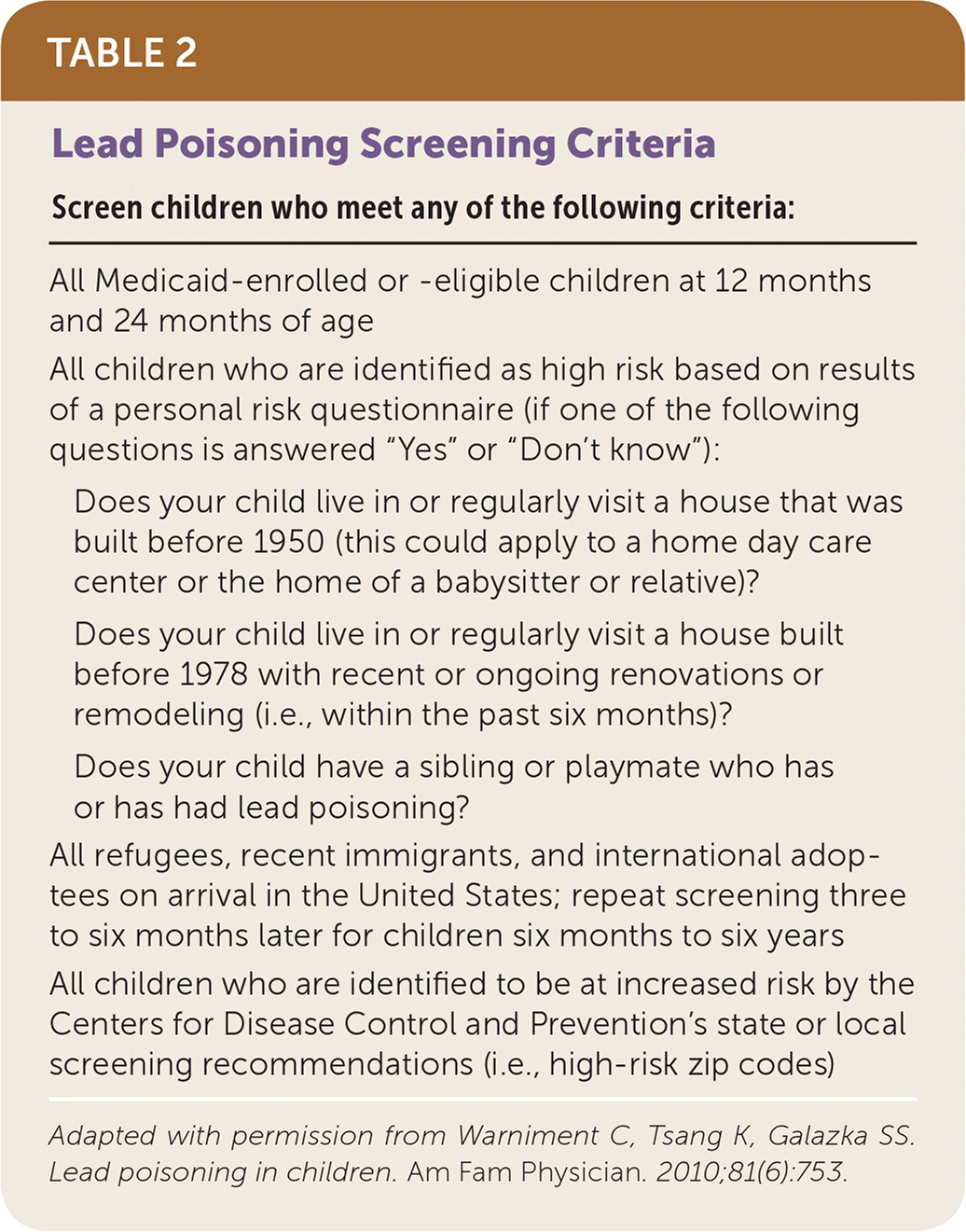
| Screen children who meet any of the following criteria: |
| All Medicaid-enrolled or -eligible children at 12 months and 24 months of age |
All children who are identified as high risk based on results of a personal risk questionnaire (if one of the following questions is answered “Yes” or “Don't know”):
|
| All refugees, recent immigrants, and international adoptees on arrival in the United States; repeat screening three to six months later for children six months to six years |
| All children who are identified to be at increased risk by the Centers for Disease Control and Prevention's state or local screening recommendations (i.e., high-risk zip codes) |
Initial screening may be performed with a capillary blood test. Any abnormal result must be confirmed with a venous sample. The timing of confirmation testing varies according to the initial value. The higher the value, the higher the urgency (Table 3).18 Although laboratories are required to have a margin of error of less than 4 μg per dL (0.19 μmol per L),9 most are routinely able to achieve a margin of ± 2 μg per dL (0.10 μmol per L). However, this degree of error can still lead to misclassification of children and unnecessary worry or inappropriate reassurance.
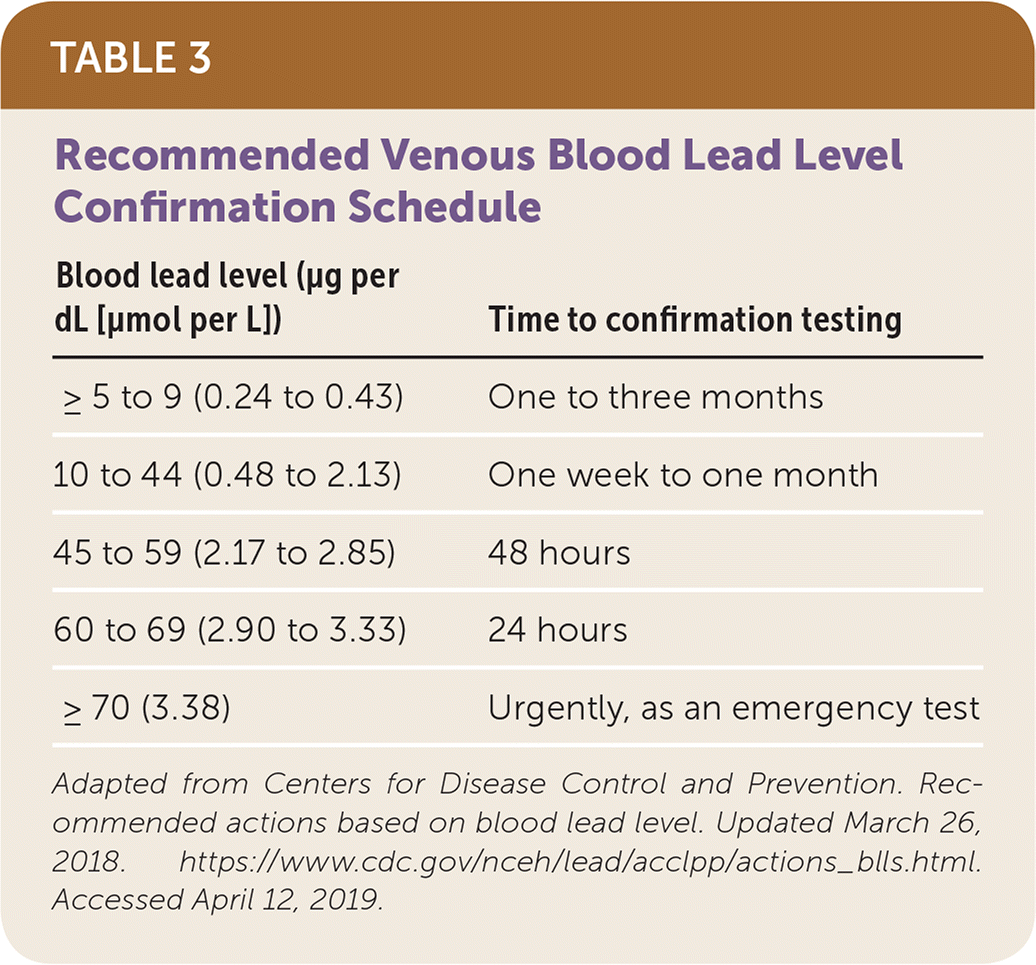
| Blood lead level (μg per dL [μmol per L]) | Time to confirmation testing |
|---|---|
| ≥ 5 to 9 (0.24 to 0.43) | One to three months |
| 10 to 44 (0.48 to 2.13) | One week to one month |
| 45 to 59 (2.17 to 2.85) | 48 hours |
| 60 to 69 (2.90 to 3.33) | 24 hours |
| ≥ 70 (3.38) | Urgently, as an emergency test |
Management
Symptomatic lead poisoning is an emergency and the child should be hospitalized immediately. If ingestion of a lead-containing object is suspected, radiographs should be performed to locate it within the gastrointestinal tract to help guide management for removal or excretion. Chelation therapy is recommended when blood lead levels rise above 45 μg per dL, whether in acute or chronic ingestion.18 Clinicians should consult a poison control center before beginning chelation therapy. Four common chelants exist: dimercaprol (BAL in Oil) and edetate calcium disodium (Calcium Disodium Versenate) are administered parenterally, and dimercaptosuccinic acid and penicillamine (Cuprimine) are oral agents. Table 4 lists CDC-recommended management for different confirmed blood lead levels.2,18
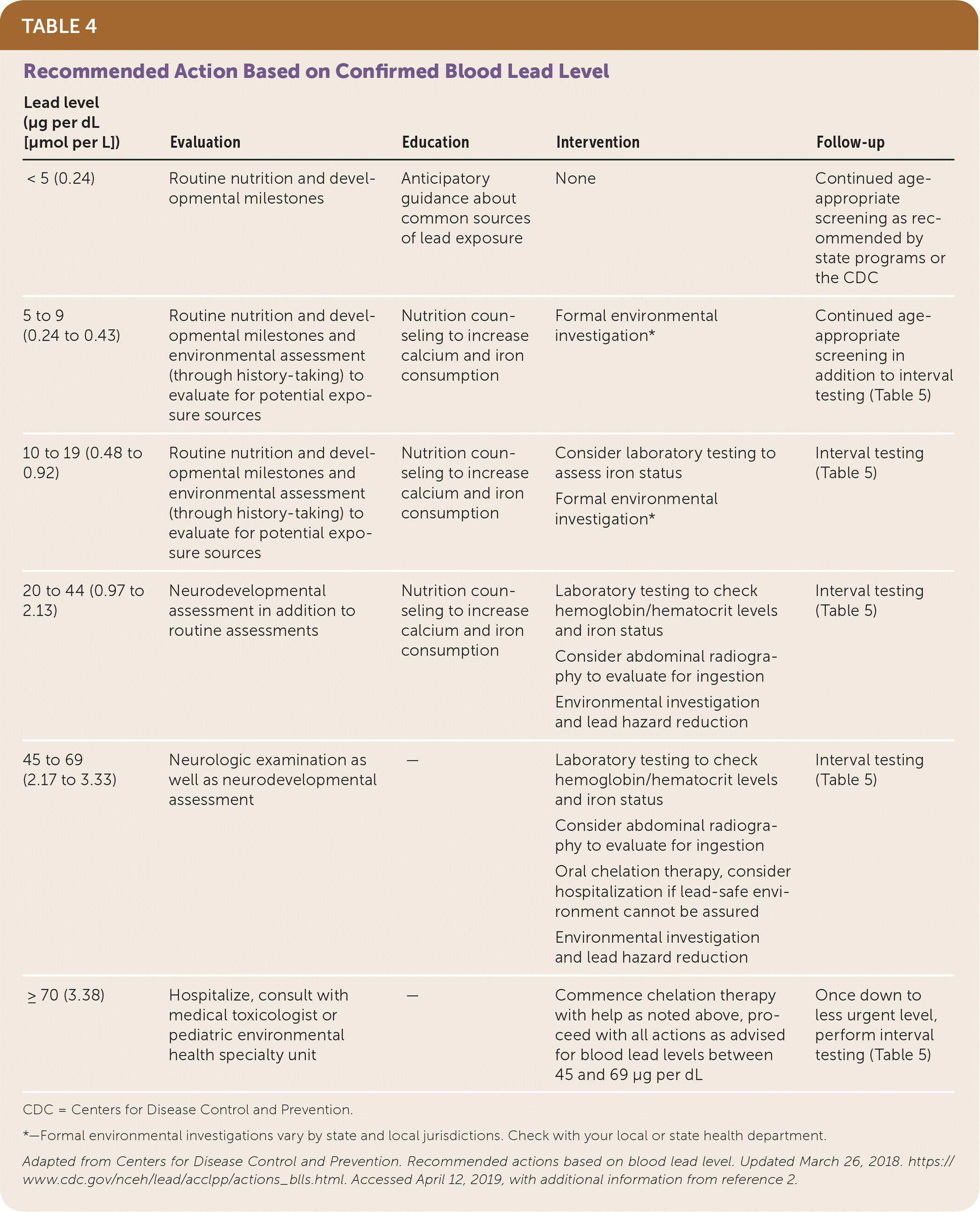
| Lead level (μg per dL [μmol per L]) | Evaluation | Education | Intervention | Follow-up |
|---|---|---|---|---|
| < 5 (0.24) | Routine nutrition and developmental milestones | Anticipatory guidance about common sources of lead exposure | None | Continued age-appropriate screening as recommended by state programs or the CDC |
| 5 to 9 (0.24 to 0.43) | Routine nutrition and developmental milestones and environmental assessment (through history-taking) to evaluate for potential exposure sources | Nutrition counseling to increase calcium and iron consumption | Formal environmental investigation* | Continued age-appropriate screening in addition to interval testing (Table 5) |
| 10 to 19 (0.48 to 0.92) | Routine nutrition and developmental milestones and environmental assessment (through history-taking) to evaluate for potential exposure sources | Nutrition counseling to increase calcium and iron consumption | Consider laboratory testing to assess iron status Formal environmental investigation* | Interval testing (Table 5) |
| 20 to 44 (0.97 to 2.13) | Neurodevelopmental assessment in addition to routine assessments | Nutrition counseling to increase calcium and iron consumption | Laboratory testing to check hemoglobin/hematocrit levels and iron status Consider abdominal radiography to evaluate for ingestion Environmental investigation and lead hazard reduction | Interval testing (Table 5) |
| 45 to 69 (2.17 to 3.33) | Neurologic examination as well as neurodevelopmental assessment | — | Laboratory testing to check hemoglobin/hematocrit levels and iron status Consider abdominal radiography to evaluate for ingestion Oral chelation therapy, consider hospitalization if lead-safe environment cannot be assured Environmental investigation and lead hazard reduction | Interval testing (Table 5) |
| ≥ 70 (3.38) | Hospitalize, consult with medical toxicologist or pediatric environmental health specialty unit | — | Commence chelation therapy with help as noted above, proceed with all actions as advised for blood lead levels between 45 and 69 μg per dL | Once down to less urgent level, perform interval testing (Table 5) |
In asymptomatic children, the CDC and American Academy of Pediatrics recommend that case management begin at blood lead levels of 5 μg per dL or greater.9 Clinicians should formally request an environmental lead investigation from their local or state health department. Parents or guardians should be questioned about common potential lead exposure sources listed in Table 1.2,4
Once elevated blood lead levels are identified, they should be monitored closely. Early on, levels are monitored more often to ensure blood lead levels are not rising more quickly than anticipated, and to document decline. Once blood lead levels begin to decline, monitoring should be continued according to the original level (Table 5).18
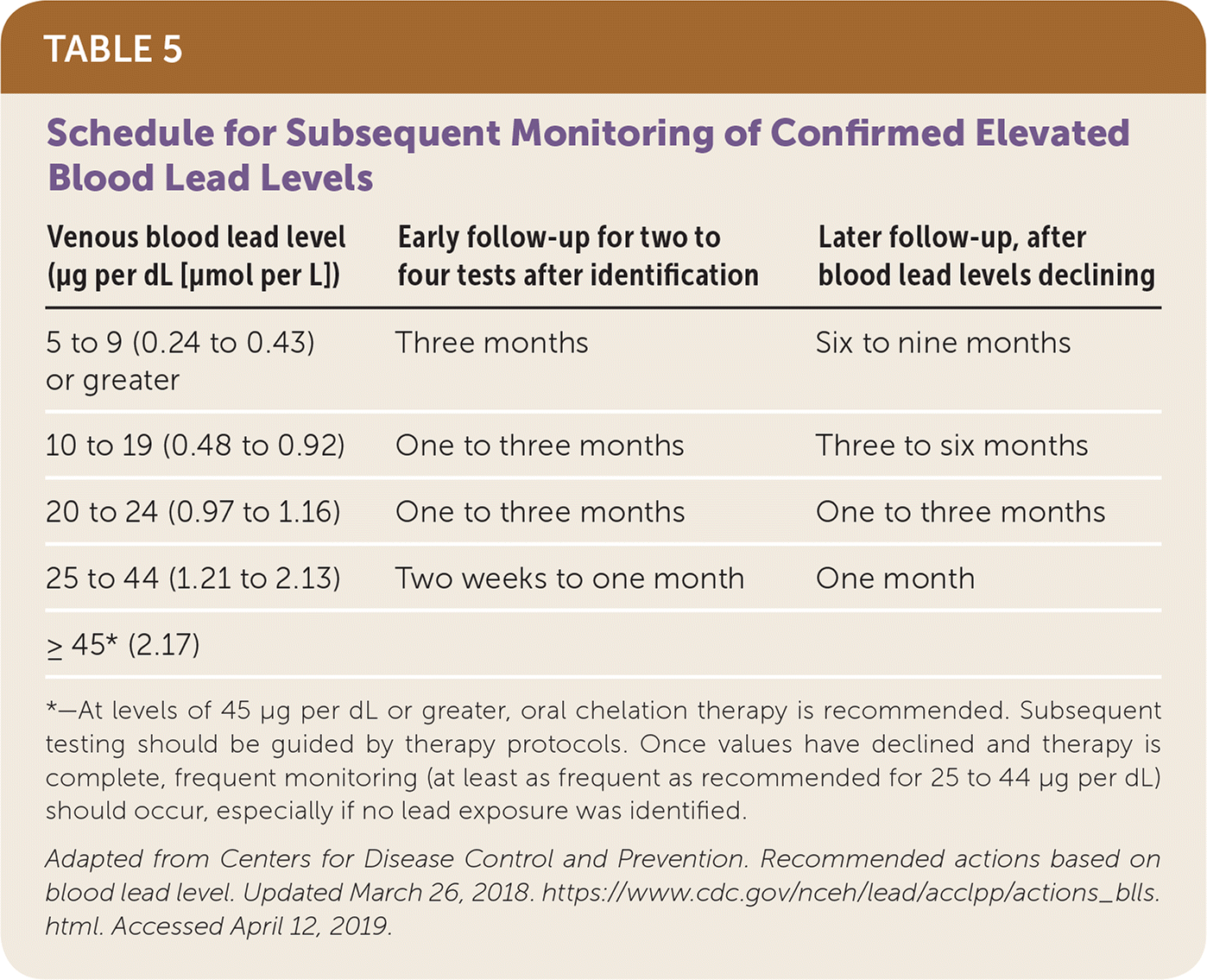
| Venous blood lead level (μg per dL [μmol per L]) | Early follow-up for two to four tests after identification | Later follow-up, after blood lead levels declining |
|---|---|---|
| 5 to 9 (0.24 to 0.43) or greater | Three months | Six to nine months |
| 10 to 19 (0.48 to 0.92) | One to three months | Three to six months |
| 20 to 24 (0.97 to 1.16) | One to three months | One to three months |
| 25 to 44 (1.21 to 2.13) | Two weeks to one month | One month |
| ≥ 45* (2.17) |
Prevention
The deleterious effects of lead ingestion on children's neurocognitive and behavioral development are irreversible4,13; therefore, primary prevention of childhood lead poisoning is paramount. Potential lead hazards in soil, dust, paint, and water need to be identified and removed before children are exposed. Geospatial and housing data for areas where children with elevated blood lead levels live can be used to guide environmental testing of paint in older housing. When identified, lead-safe practices must be used during renovation and abatement.
Primary prevention is possible at the individual level through anticipatory guidance for all parents. Clinicians can counsel parents to be aware of the age of their housing and, when possible, to have older homes tested for lead paint before purchasing them or moving in.19 Parents should regularly wash children's hands and toys to keep them free from lead-containing dust. Floors and windowsills should be regularly wet-mopped, at least every two weeks. Shoes should be removed before entering the house to prevent contamination from lead-containing soil. Parents should be cautioned about the potential risks of folk remedies or imported medicine and imported food, candy, or pottery, especially from developing countries. The U.S. Consumer Product Safety Commission maintains a website for recalls of lead-containing goods at https://www.cpsc.gov/. Household tap water can be tested for lead and, if found, lines should be flushed by flushing toilets and showering and bathing before using water for cooking. In addition, only cold tap water or bottled water should be used for drinking, cooking, and making infant formula in households where the tap water is known to contain lead.
Once an elevated blood lead level has been confirmed, the cornerstone for prevention of further harm is to identify and remove the source of lead exposure. This is the goal of case management and environmental investigation. When this is not available, the clinician should review potential sources with the parents and encourage them to investigate on their own. They should instruct parents to follow the same general hygiene and avoidance tips listed in the previous paragraph. Studies show household interventions are more effective at preventing elevated blood lead levels than lowering them, but they are still an important step in mitigating the child's ongoing exposure.20,21 When community and personal resources are available, private contractors can test for and remediate lead exposures in housing. The U.S. Environmental Protection Agency maintains renovation, repair, and painting rules and a database of certified contractors at https://www.epa.gov/lead/pubs/renovation.htm.21
This article updates a previous article on this topic by Warniment, Tsang, and Galazka.2
Data Sources: A PubMed and Google scholar search was conducted using the key terms pediatric lead poisoning, lead poisoning in children, history of lead poisoning, lead poisoning in the United States, and lead poisoning. Also searched was Essential Evidence Plus, and the Centers for Disease Control and Prevention website was searched for the key terms lead poisoning and lead. Search dates: March 2 to September 21, 2018, and April 12, 2019.
